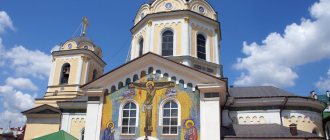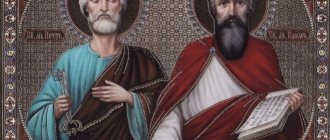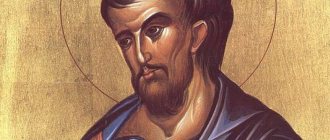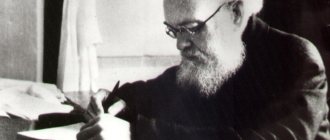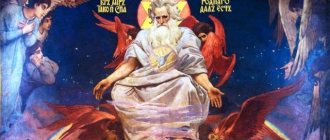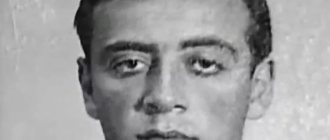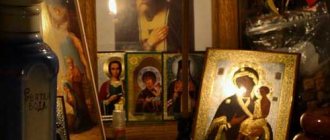Apostle Luke - icon painter
The legend about how the Apostle Luke - one of the 70 apostles, a companion of the Apostle Paul, a Greek doctor and preacher - wrote the image of the Mother of God either on a cypress tablet or on the board of the table at which Jesus, the Virgin Mary and Joseph had a meal, is included in the number of well-known legends, the reliability of which is easy to question by skeptics, but which do not require any “scientific” analysis.
Of course, real veneration of icons begins only in the 4th century; Of course, in the icon the Mother of God appears young and with the Child Christ in her arms, while, according to legend, the icon was painted by Luke 15 years after the Ascension... But the story is not about these boring matters. And about the very possibility of capturing the earthly, bodily image of Christ and the image of his Mother, capable of containing the Divine Youth.
D. Mazaev
Source: Baptist Magazine, No. 3, 1909There is a well-known tradition, shared equally by Orthodox and Catholics, which traces the antiquity of the image of the Mother of God to the time of her life and connects their beginning with the name of the Evangelist Luke. How reliable this legend is is, of course, a question, since it has been disputed since ancient times and continues to be disputed, but if its reliability were proven, it would put an end to all disputes and stop the mouths of all iconoclasts, for it would resolve the issue of icon veneration historically and would give people not the fabrications of fantasies, but an accurate depiction of the revered face to the point of portraiture, for, as is known, illiterate and ignorant icon painters allowed God the Father, the pre-eternal birth of Jesus Christ, the Annunciation, etc., to be depicted “from their own conception”, “in absurd and indecent, - as the Council says, “visions,” attributing to God the folding of fingers and “many other placeless things,” thereby doing a disservice to the defenders of icon veneration and bringing upon themselves the just condemnation of both individual saints and entire councils.
Thus, our Russian Moscow Council of 1666-1667, noticing many irregularities in the veneration of icons and condemning them, says: “The Lord of hosts (that is, the Father) is gray-haired and the only begotten Son in His womb to write on icons and a dove between them is extremely absurd and indecent to eat, who sees the Father according to deity? For the Father did not have flesh, and the Son was not born in the flesh from the Father before the ages, even if David the prophet says: “Out of the womb before the star was born thee,” otherwise that birth is not carnal, but ineffable and incomprehensible. For Christ Himself says in the Holy Gospel: “No one knows the Father’s message, save the Son.” And Isaiah the prophet in chapter 40 says: “To whom will you liken the Lord? and to what will you liken Him? Whenever you create an image of a treemaker, or a goldsmith, merge gold and gild it, or create it in its likeness.” In the same way, St. Paul the Apostle in Acts says in chapter 17 beginning 40: “For the generation that is of God, we must not eat food, as a god is gold, or silver, and the understanding of man” (in the Russian translation this passage reads like this: “So, we, being the race of God, should not think that the Divinity is like gold, or silver, or stone, which received an image from the art and imagination of man,”
Acts 17:29). John of Damascus also says: “Who can imitate this invisible and incorporeal and indescribable and unimaginable God? It would be extreme madness and wickedness to form a deity.” Saint Gregory the Dvoeslov also forbids about this: “for the sake of Hosts, who is the Divinity, and that formerly eternal generation of the Only Begotten Son from the Father, it is fitting for us to understand with our minds, but writing in images is by no means appropriate and impossible.”
“And the Holy Spirit,” continues the Council, “is not the essence of a dove, but the essence of God is, and no one has seen God, as John the Theologian and Evangelist testifies. Moreover, at the Jordan, at the holy baptism of Christ, the Holy Spirit appeared in the form of a dove, and for this reason in that place it is proper to write the Holy Spirit in the form of a dove, but in another place those who have reason do not depict the Holy Spirit in the form of a dove.”
“They also write in icons about the Holy Annunciation of Hosts, who breathes from the mouth and that breath goes into the womb of the Most Holy Theotokos. And who saw it? or does some holy scripture testify to this? and where did you get this from? It is clear that this is the custom, and something like this from some foolish people, or even more so, the words of the wise and the crazy are accepted as a custom. For this reason, we command that from now on let that vanity and placeless writing cease.” (Acts of the Council of 1667, sheet 22-24.)
Taking into account all of the above, one cannot be surprised that in ancient times in the Russian Orthodox Church there was an image of St. Christopher with a dog’s head. Saint Christopher, as they say, was very ugly in appearance, which is why the writer of his life, speaking about his appearance, used the expression “beast-like,” and the icon painter went even further and gave him a dog’s head.
We should rejoice that, thanks to iconoclastic disputes, conciliar condemnation and the spread of spiritual enlightenment, all these images “in absurd and indecent visions” were relegated to the realm of legend...
But let's turn to our subject. Knowing about the existence of a tradition about the artistic activity of the Evangelist Luke, I was surprised that the defenders of icon veneration, always dwelling for a long time in their evidence on the decorations of the Jerusalem Temple with its chased or cast cherubs, lions and oxen, do not turn at all to the tradition about the Evangelist Luke. In my opinion, the evidence of this tradition should be placed at the forefront, given before all other evidence, since it would simultaneously prove the existence of icon veneration in the Apostolic Church and would, as I already said about the image itself, not be a figment of imagination “from one’s own plans”, but a real image, painted from life. Of course, I interpreted all these silences not in favor of icon worshipers and icon veneration, but on the contrary, because this convinced me that the evidence in favor of the artistic activity of the Evangelist Luke is so weak that even the defenders themselves do not believe in the possibility of convincing with their help, except themselves, no one else.
This went on for quite a long time, until I quite accidentally came across an article by a certain Alexander Golubtsov, “On the most ancient images of the Mother of God,” which he published in the “Theological Bulletin” for 1897. This article, with its impartial analysis of historical evidence “for” and “against”, made the most pleasant impression on me: I saw in it a person not trying to defend his point of view at all costs, but trying to find out the essence of the matter through impartial research. Reading this article shed a lot of light on the question that occupied me and gave me the opportunity to understand it and draw my own conclusions.
First of all, I must say that the author of the article firmly believes in the truth of this tradition, successfully refutes unsuccessful objections to it and conscientiously reveals all the difficulties that he himself encounters in this matter. He says:
“The first who has an indication of the icon of the Mother of God by the latter (that is, the Evangelist Luke) is Theodore the Reader, a historian of the times of Justin and Justinian, preserved in fragments in some ancient manuscripts, most of all in the church history of Nikephoros Callistus. He reports that Empress Eudokia, the widow of Theodosius the Younger, having gone to worship in Palestine, sent from Jerusalem to Constantinople her sister Pulcheria, the wife of Emperor Marcian, an image of the Mother of God, painted by the Evangelist Luke. Speaking about the event briefly, without any explanations or reservations, the historian, as it were, makes it clear that he has in mind an indisputable fact known to everyone. However, after Theodore the Reader, we do not find its confirmation in written monuments for more than two centuries.
But from the 8th century there are several almost similar news about the icon that occupies us.
St. Andrew of Crete, who died a martyr in 761, proves the use of St. icons, among other things, refers to the universal evidence that St. Luke "with his own hand depicted both the incarnate Christ himself and His immaculate Mother" and that these images, famous in Rome, are in Jerusalem. The unknown author of the “Tale on Icons to Constantine Copronymus,” using the fact that St. Luke depicts the Mother of God for the same apologetic purposes, and notes about the icon that it was sent by an evangelist to a certain Theophilus.
In the famous life of Stefan Novago, who suffered for St. icons in 757, it is said that the Archbishop Germanus of Constantinople, exhorting Leo the Isaurian to abandon the idea of persecuting icon veneration, in confirmation of the antiquity of sacred images, in addition to the statue of the Savior erected by a bleeding wife and the Edessa Ubrus, also pointed to the image of the Virgin Mary, written by the Evangelist Luke and then sent somewhere from Jerusalem.
In the “Message to Emperor Theophilus about St. icons", attributed by scientists to the year 845-846 and attributed to three Eastern patriarchs, it is reported that the divinely inspired Luke, during the life of the Most Holy Theotokos, while She lived in Zion, drew Her honest image on a board with picturesque compositions for subsequent generations and from the mouth The Virgin Mary herself heard the promise that Her grace would remain with his icon.
Simon Metaphrastus, a great lover of rhetoric, who compiled 132 biographies of saints, at the beginning of the 10th century conveys the legend that interests us in a somewhat common edition: “The most gratifying thing is,” he writes, “that the Evangelist Luke is the human form of my Christ and the image of She who gave birth to Him and gave Him human nature, first depicting them with wax and paints, conveyed that they would be honored even to this day, considering it insufficient if he did not contemplate in images and images the features of their faces, which serves as a sign of his ardent love. And he did this not only for himself, but also for all the faithful who love Christ.”
In the famous menology of Emperor Vasily the Bulgarian Slayer (976-1025), it is briefly and clearly stated that the Evangelist Luke, a native of Antioch, was a doctor and painter by occupation.
Theophan Keramevs, Archbishop of Tauromenia (1130-1150), in a conversation for the week of Orthodoxy, revealing with examples the idea that the veneration of icons from time immemorial and from above is established, adds in conclusion: “and Luke, the eloquent evangelist, painted with wax and paints the icon of the Mother of God holding the Lord in their holy hands, which is preserved to this day in a certain city,” that is, in Constantinople.
We find comparatively more complete information on this issue for the first time in the church history of Nikephoros Callistus.
Noting, in agreement with Vasiliev’s menology, that St. Luke was a doctor and at the same time a very knowledgeable painter, the latter writes: “They say that he was the first to depict in painting the image of Christ and the Godly One who gave birth to Him, and also the Supreme Apostle, and that from him this high and venerable art later spread throughout the entire universe.”
Without providing any more information about the images of the Savior and the apostles Peter and Paul by St. Luke, Nikephoros Callistus does not leave us in the dark about his icons of the Mother of God and twice, although for the same reason, mentions her subsequent fate.
Talking about the religious zeal of the Empress Pulcheria, listing the churches in honor of the Mother of God that she built, he says: “The second Hodegetri church, where she placed the icon of the Mother of the Word sent from Antioch, which the divine Apostle Luke painted with her own hand during Her lifetime. She saw this image and imparted grace to her image. This icon first worked miracles in a place called the Tribunal, which are still performed today. Pulcheria established that in this temple on the third day of the week there should be a vigil and prayer, which is observed to this day.
Without citing here the rather numerous and varied news about the miraculous Hodegetria Icon of the Mother of God from Byzantine and medieval Western writers, we will only note that this shrine, according to the unanimous testimony of all of them, enjoyed the reverent veneration of all the Byzantines, was very important in their political history and was well known by rumors and copies from it to Western Christians. The legend about the painting of this icon by the Evangelist Luke himself was widespread among the Byzantines, did not arouse any distrust in them and, of course, could only be included in the Greek icon painting original as an undoubted fact of religious life.
The later compiler of the latter, who was strongly influenced by this tradition, giving instructions to painters about depicting the appearance of the apostles and evangelists, about St. Luke briefly says: “The Evangelist Luke is not old, curly, with a small beard, depicts an icon of the Mother of God.” And indeed, on some ancient icons and in miniature manuscripts we see him with icon-painting accessories, painting an icon of the Mother of God or already presenting his completed work to Her. Most often, this kind of illustration can be found in Russian manuscripts next to those already known to us: “Tales about the icon image, how and when it began” and “Tales about the painting of the icon of the Mother of God Hodegetria,” precisely against the following words of the text, which are not devoid of interest in this case: “ After the resurrection and ascension into heaven of our Lord Jesus Christ and after the outpouring of the Holy Spirit, the past fifty years, the glorious apostle and evangelist Luke, to him is praise in the gospel of Christ, who wrote the gospel about Christ about the Ever-Virgin Mary who gave birth to Him, as well as the Acts of the Holy Apostles into books. And again, that first divine image, hedgehog painting, was self-righteously in the habit of writing on the table the outline of our Most Pure Lady Theotokos and Ever-Virgin Mary, likening Thy graceful vision to dangerous... And brings it to the archetype of the mistress and all the Queen. She, having laid her eyes on that icon and... having rejoiced, speaks to him with reverence and with authority: “Let my grace be with you.”
The attributes of the artistic title became, as it were, a distinctive iconographic feature of the Evangelist Luke, and for a long time he himself was considered in the Christian world the patron saint of icon painters, under whose protection entire societies of artists arose and existed in the West in the pious medieval era.”
(Golubtsov, pp. 38-43.)
This is all that an Orthodox writer could cite in defense of the tradition, and that any other defender of Luke’s iconographic art can cite, so all of the above here is the basis and foundation of this tradition, on the strength of which everything depends.
While defending this legend, Golubtsov also takes into account the objections and - we must give him his due - refutes them very skillfully. So, he says:
“A tradition that has a long line of substantially consistent witnesses should not raise doubts about its authenticity, and yet many of the scientists who dealt with the tradition in question did not believe in its authenticity. Some, but very few, archaeologists have even tried to explain the origin of this, as they say, legend and to undermine the strength of those who speak in favor of its evidence. The legend about the painting of the icon of the Mother of God by the Evangelist Luke, they say, has no solid support and is nothing more than a misunderstanding based on the confusion of two completely different names. The Madonnas known as Luca are actually the works of an 11th century Florentine painter named Luca Santo. Written by the latter, they were later attributed to the evangelist out of oblivion, due to the identity of the name and under the influence of a completely understandable desire to connect the origin of this or that respected shrine with the names of more remarkable and famous church figures. This explanation may be true in relation to some of those numerous Madonnas who are presented as icons of the Evangelist Luke in Italy and other places in Western Europe, but in relation to the tradition that occupies us, it is, however, a witty, but arbitrary and non-explanatory guess . Evidence of the painting of the icon of the Mother of God by the Evangelist Luke warns the Florentine painter for several centuries, thereby making it clear that the legend did not arise with him or after him, as would follow according to the hypothesis under consideration, and existed long before Luca Santo. A similar inconsistency characterizes most of the objections that were invented and directed as negative criticism against the grounds given by the opposite side in defense of the authenticity of the legend about the Evangelist Luke as an icon painter.”
(Golubtsov, pp. 43-44.)
Without saying anything on my own for now and leaving Mr. Golubtsov to continue speaking, I also cite what he could say on his own against this legend. He says:
“The initial fate of the images of the Mother of God is very poorly illuminated in the monuments of ancient Christian writing, incomparably less than the artistic history of the image of Christ, and therefore can be traced on the basis of a very small number of literary data. From the first three centuries of Christianity, no indications relating to the iconography of the Mother of God have reached us, and evidence from the 4th-5th centuries and some a priori considerations speak, apparently, even against the existence at that time of genuine Her images or recognized as such. “We do not know the face of the Virgin Mary,” wrote Blessed Augustine, “from whom Christ was born, unmarried and incorruptible, miraculously... We believe that the Lord Jesus Christ was born from the Virgin, whose name is Mary... But did Mary have such a face as appears in in our minds, when we talk or remember about it, we are not at all aware and not convinced. You can say, keeping faith, maybe She had such a face, maybe not like that.”
We do not think that these words have anything to do with the images of the Mother of God and only mean that the bl. Augustine, on behalf of himself and on behalf of his contemporaries, wanted to say: “Neither I nor they saw the Mother of God, and therefore we do not know what kind of face She was.” If in the Church of Ipponia at the time when Bl. lived and ruled it. Augustine (d. 430), there existed and were generally known to be authentic, faithful to the portrait images of the Mother of God, and the church would give them faith as such, then Bl. Augustine could not have spoken so decisively about his and his contemporaries’ ignorance of the face of the Mother of God. The insufficient acquaintance of the first proselytes of Christianity with the fine arts, the solitude and isolation of Eastern women, who appeared only with a veil over their faces, and finally, the special, unusual modesty of the Blessed Virgin, who avoided all ostentation: “She composes verbs in her heart” (Luke 2 :19, 51), apparently can also serve as indirect evidence against the appearance of portrait images of the Mother of God among the leading Christians.”
(Golubtsov, p. 1, 2).
Without limiting himself to the general considerations expressed, an honest and impartial researcher analyzes the evidence he provides and expresses personal difficulties in accepting on faith the validity of the tradition in question. Refuting the opinion that the icon of the Mother of God was painted by the Florentine painter Luca Santo, he, among other things, writes:
“We do not see the need to bring here all these objections, partly refuted by the latest discoveries in the field of ancient Christian catacomb painting, partly already examined in Russian archaeological literature, but it is impossible to pass in complete silence two or three serious bewilderments that this can and did arouse in the soul of an impartial researcher tradition.
The Empresses Eudoxia and Pulcheria, whom Theodore the Reader names when first reporting on the icon of Our Lady of the Evangelist Luke, are two remarkable female figures in the cultural history of Byzantium in the fifth century. The first, the daughter of a philosopher, was famous for her curiosity, classical education and devoted her leisure time to literary works, commenting on the book of Genesis and describing in verse the exploits of martyrs; the latter was distinguished by her piety, love of temple building, and her name is associated with several monasteries built in Constantinople and its environs.
The church historian Sozomen devotes several chapters of his fourth book to praise the virtues of Pulcheria and her sister, the good teaching that she instilled in her brother the emperor; her steadfastness in Orthodoxy, which prevented the development of new heresies that emerged in the 5th century; religious women's community founded by the sisters and talks in detail about the discovery of the relics of the martyrs. Another church historian, Socrates, in the penultimate chapter of his history, mentions the pilgrimage of the Empress Eudoxia to Jerusalem in 438 and the many contributions she made to various churches in the East. But it is remarkable that neither one nor the other historian talks at all about the precious parcel sent by the empress from Jerusalem to Constantinople to her crowned sister.
(Italics are mine throughout. - D. M.).
Even more remarkable and incomprehensible in this case is the silence of the VIIth Ecumenical Council, which in its testimonies on the veneration of icons did not mention this very important circumstance in a single word.
It is clear that the Council, which very carefully examined and searched for ancient news about icons, in support of Orthodox teaching, twice in its actions referred to the story of Theodore the Reader, either considered the latter’s testimony about the icon of the Mother of God of the Evangelist Luke weak,
or did not know it at all.
Otherwise, the icon, revered by everyone, located in one of the most famous monasteries of Constantinople, gathering crowds of pilgrims around it, should have served as a strong argument for veneration of icons.
The silence of the Council Fathers about this icon will give reason to doubt that there was an icon in Constantinople at that time known with the name of the Evangelist Luke, and therefore for the reliability of the mention of it by Theodore the Reader there is not enough solid ground.
Evidence of this icon appears, and then independently of Theodore the Reader, in the era of iconoclasm and among less competent writers, for example, in anonymous messages about icons in the life of Stefan Novago and other writings.
In addition to these chronological, so to speak, difficulties associated with the history of the legend about the icon of the Mother of God, written by the Evangelist Luke, the reliability of the legend in question is also suspected on the basis of some historical considerations. The artistic activity of the Evangelist Luke is nothing more, they say, as an assumption devoid of solid foundations. The Apostle Luke, as we know, was a doctor in his occupation and nowhere - neither in the Holy Scriptures nor among the writers of the Church of the first centuries - is there even a hint that he was a painter or would have painted an image of the Blessed Virgin. Moreover, according to tradition, he is recognized as one of the seventy apostles and, therefore, a Jew by origin. But it is known that painting, along with other fine arts, was not familiar to the Jews due to the commandment not to make likenesses like those in heaven and earth.
By admitting, in agreement with some ancient teachers of the Church (Tertullian, Jerome, Augustine) and the newest scholars of the Holy Scriptures, that the Evangelist Luke was a native of the pagans, it will be easy to get out of the difficulty just indicated and to significantly weaken the force of the objection associated with it. It is much more difficult to resolve the confusion caused by the silence of historians and the fathers of the Council of Nicea about the precious shrine sent from the East.”
(Golubtsov. p. 44-46).
Such are the general bewilderments of the author of the study of the authenticity of the legend in question. These perplexities, of course, do not diminish if we take into account that there was only one icon attributed to the Evangelist Luke, and yet in Greece the following are considered such: Blachernae, the Merciful on the island of Cyprus and Kik; in Russia: Vladimirskaya, Smolenskaya and Tikhvinskaya; in Rome, icons in churches are attributed to the Evangelist Luke: Mary the Great, St. Dominica and Sixta; in Poland - Czestochowa, and also the fact that from the testimony of Theodore the Reader it is clear that the icon, painted by the Evangelist Luke around the middle of the 5th century, was transferred from Jerusalem to Constantinople and then was in the Odigitrievsky Monastery. In the 12th century, according to Theophan Keramevs, it continued to be preserved in Constantinople, and meanwhile, long before that time, we in Rus' already knew the icons of Our Lady of the Evangelist Luke, brought in the 11th-12th centuries from Constantinople, and in Catholic countries (for example, in Rome) and earlier, icons attributed to the same evangelist were shown (see Golubtsov, p. 47).
Now, after everything that the researcher could say on the issue that concerns us, it is my turn and I must say my word.
Having at hand the testimony of the Orthodox priest Fr. John of Orphanitsky against the icon of the Tikhvin Mother of God attributed to Evangelist Luke, who states in print that “this icon belongs to St. Evangelist Luke is more than doubtful” and proves this opinion by the fact that, firstly, it is unknown who was the writer of this icon; According to an older legend, it was written by St. Herman, Patriarch of Constantinople, and from Constantinople “came to Tikhvin by air” (Thurs. Min. June 26). “Yes, it’s enough,” he says, “to look only at the very size of the icon to see that it was painted for a temple, and not for a home: icons of such large sizes are not and have not been painted for a home; and on the days of St. Evangelist Luke there were no churches yet” (“Friend of Truth”, 1899, No. 44, pp. 858-859).
But I do not consider this fact particularly important and do not rely on it. Moreover, if I had the same reviews regarding all the icons attributed to the Evangelist Luke in Russia and abroad, I would not quote them verbatim and would limit myself to just references, since in this case I do not even find it necessary to touch on all these icons or at least any of them and I have to speak only regarding the content of that icon, which was once attributed to St. Luke, regardless of its size and regardless of whether it exists at a given time or does not exist.
I briefly and decisively declare that the icon that is attributed to the Evangelist Luke does not belong to him and cannot belong to him, and here’s why.
1. The “Tale of the Writing of the Icon of the Mother of God Hodegetria” that I cited above tells us that the Evangelist Luke “wrote on the icon the inscription of our most pure Lady Theotokos and Ever-Virgin Mary” and that he did this “ last fiftieth summer”
after the outpouring of the Holy Spirit, that is, 15 years after the ascension of Jesus Christ.
We know that Jesus Christ, beginning His ministry, was about thirty years old (Luke 3:23), it is also not difficult to establish that He performed His ministry for three and a half years, and if we add here the 15 years that passed from the ascension Christ until the time when the Evangelist Luke painted his icon, it will be about 49 years. Moreover, we must not lose sight of the fact that we count the years from the birth of Jesus Christ, and the icon was painted not from Christ, but from His mother, who at the time of the birth of Jesus was at least 19 to 20 years old, so, adding all these numbers together, we learn that the Mother of God at the time of painting her icon was about 70 years old and was, therefore, quite elderly. Turning to the icon, we see her there completely young, at the age of no more than 20 years, which in no way could have happened when painting the icon from life and, moreover, by a person who was “self-consciously accustomed” to this purpose.
2. On the icon we are considering, according to the testimony of Theophan Keramevs (which is given above), the Mother of God was depicted “holding the Lord in her holy hands,” so this involuntarily raises the question: how could the Evangelist Luke, who wrote, as they say, from life, place Jesus Christ in the form of a baby in the arms of His mother almost 50 years after His birth and 15 after His ascension into Heaven, when He, according to the undoubted and cumulative testimony of other evangelists, apostles and the same Luke, was already sitting at the right hand of the throne of the Majesty on high (Luke 24:50, 52, Acts 1:1, 9, 9)? “Luke couldn’t do that.”
3. On the icon of the Mother of God attributed to Evangelist Luke, the Infant Jesus is depicted with the fingers of his right hand folded (it is unknown - for the sign of the cross or for blessing), as a result of which this icon is considered, as is known, to be serious factual evidence in disputes between Old Believers and Orthodox Christians.
This circumstance strongly convinces us that this icon does not belong to the Evangelist Luke and cannot in any way be attributed to him. Evangelist Luke describes the birth of Jesus Christ and all the events that preceded it and followed it - the annunciation, bringing to the Temple for circumcision, etc., in comparison with other evangelists, in more detail and detail, and yet nowhere: neither at the birth of Christ, nor in His service, nor during His ascension to heaven, there is no mention either directly or indirectly of the folding of fingers, but on the contrary, it testifies that Christ, bidding farewell to the disciples and ascending to heaven, blessed them, “raising His hands” (Luke 24:50 ). Which blessing was not some new, Orthodox one, but was ancient, Israeli (Lev. 9:22). That this blessing was one way and not another, impartial researchers of the Holy Scriptures of all churches agree on this, and the only exceptions are those few artisans of religion for whom recognition of the true state of affairs in a certain sense is not beneficial.
A well-known and respected saint of the Russian Orthodox Church, St. Dmitry Rostovsky in his book “Search”, by the way, writes that “Christ was never baptized with his hand, and did not give commandments about this to anyone, either personally or through the apostles, and that Christ did not fold his fingers, and during his ascension blessed his disciples with his whole hands . It has become a custom for people to fold their fingers; This custom is good, but it is not a dogma of faith” (Part II, sheet 258, 259).
This is my opinion and these are my reasons, and I cannot help but regret that this tradition and this icon were not the subject of judgments of that Russian Council, excerpts from the acts of which I cited at the beginning of my present work. I really like his no-nonsense attitude and his decisive tone. If he saw something that did not correspond to the truth, he always asked questions: “Who saw it?”, “What holy scripture testifies to this?” and “Where did you get this from?”, and if he did not receive a satisfactory answer, then he attributed it to superstition or foolish wisdom and resolutely declared: “The icon painters of the holy wonderworkers Peter, Alexy and Jonah in white hoods painted falsely, before they did not wear white hoods, and below This custom is still practiced in Russian countries” (Acts, 1667, sheet 24).
Leaving aside the icon, I consider it necessary to say a few words in conclusion about the tradition itself, which I look at as the transmittal document with which the icon we are considering and attributed to the Evangelist Luke was transmitted.
The articles cited by the author and the “Message to Emperor Theophilus on Holy Icons” and “The Legend of the Painting of the Icon of the Mother of God Hodegetria” cited by me agree that when Luke brought the icon he had painted to the “Primeval and Queen of all,” he heard from her lips a promise that “her grace will remain with his icon.”
As I read the Holy Scriptures, I see numerous testimonies of the grace of God (Titus 2:11), the grace of Jesus Christ (2 Cor. 8:9), and the grace of the Holy Spirit (Heb. 10:29), but I have not found a single testimony neither direct nor even indirect about the “grace of the Most Holy Theotokos.” If Archangel Gabriel called her “graceful” in his greeting (Luke 1:28), it was not because she had her own grace and was gracious in herself, but only because, as he says below, she “found grace is with God” (Luke 1:30). Therefore, I admit that she could only speak as the Apostle Paul said: “The grace of God, which is with me
“(1 Cor. 15:10), but I cannot allow that the blessed among women and truly “graceful” mother of my Lord could talk about “her” grace. This is the first one.
And secondly, in both of the cited documents, Mary is called “Ever-Virgin,” “Mistress,” and even “Queen of all,” as none of the evangelists and apostles calls her. Evangelists equally call her Mary or “Mother of Jesus,” both before her birth of Jesus Christ (Matt. 1:18, Luke 1:27, 34), and after His birth (Luke 2:16, 19, John 2 :13). She is also called standing at the cross already at the end of the earthly life of the Lord Jesus (John 19:25) and so, and not otherwise, Luke calls her after the ascension of Jesus Christ to heaven (Acts 1:14).
Thus, the study of the accompanying document reveals its contradictions with the evidence of the Holy Scriptures and shows all its inconsistency, and thus perfectly explains the reason for the silence of the VIIth Ecumenical Council, which obviously (as Mr. Golubtsov quite thoroughly concludes) “ did not know at all his"
.
Image multiplication
From the very first steps, an inexperienced person has many questions and contradictions. Who brought the image painted by Luke to Constantinople? Was the image full-length or waist-length? What was the historical image like? Has it survived to this day? And where is it now? We will figure it out step by step, looking at the versions and history of the main icons. But first, let’s remember the basic principle: according to the theology of the icon, the copy from the miraculous image takes on both the name and the miraculous properties of the prototype.
And the old board was successfully replaced in ancient times with a new one, without changing either the name or the authority for believers. Because the point was and remains not in “boards and paints,” but in the image itself. Strictly speaking, for worship, a true believer needs not “the same historical plaque,” but an image that has been passed from one plaque to another for centuries - this is what distinguishes real veneration of an icon from the curiosity and awe of a collector. So, from a theological point of view, ALL the images that will be discussed further are true! Because they have a direct tradition going back to the original prototype.
The appearance of Hodegetria
First of all: historically, the “icon of Luke” is considered to be the type of Our Lady Hodegetria - on it Christ blesses with his right hand, holds a scroll or book in his left, appearing as a shepherd and Savior; The Mother of God supports him with her left hand; she sits calmly and turns towards those ahead, representing the image of the Church.
The image painted by Luke was originally located in his hometown of Antioch, then was transferred to Jerusalem, and from there in 439, Empress Eudokia, wife of Theodosius II, brought it to Constantinople and gave it to her husband’s sister, Pulcheria. Then the first “split” of the legend arises: according to one version, Pulcheria presented the icon to the Blachernae church, which is why the image began to be called Blachernae; according to another, the icon was placed in the Odigon monastery.
The end of worldly life
Luke died a martyr's death in Greek Achaia and was buried in Thebes. For a long time, sick people came to the grave and instantly received healing. The Emperor of Greece, having learned about the healing power of Luke's relics, ordered them to be delivered to Constantinople
Currently, part of the relics of the Apostle Luke are in the Basilica of St. Justina in the Venetian city of Padua.
Behind the Catholic throne on a dais is the tomb of St. Luke the Evangelist
The reliquary with the skull is located on Greek Athos in the Russian Panteleimon Monastery.
Part of the relics is in Cyprus, in the monastery of Pangia Kykkos.
Icon of St. Apostle Luke
Since Luke was an educated man, they pray before his face for help in learning. The saint is considered the patron saint of doctors, because he was a skilled healer. They pray to him for health, search for inspiration, the meaning of life. It will be useful to turn to the face before reading spiritual literature.
Saint Dmitry of Rostov in the book “Lives of the Saints” (Cheti Menaion) described the worldly life, deeds and miracles of many great saints. The stories about them are arranged in the order of months and days. The October/18 section tells about St. Luke - Life of the Holy Apostle and Evangelist Luke (Life 914).
Image from Odigon
The miracles of Hodegetria begin in 453, when she was carried out from the Odigon monastery to the walls of the city during the invasion of enemies - and she put them to flight. Every Tuesday, Hodegetria was carried out by 20 people from Odigon and carried in a special procession through the entire city to the monastery of Pantocrator and back; at the same time, the massive icon “flyed” through the air - it was carried one by one on the back, spinning and passing it to each other in a sacred dance. It was this icon that was considered the main shrine and guardian of Constantinople.
It survived the capture of the city by the Crusaders in 1204, probably still remained in it; on the eve of the capture of the city by the Turks in 1453, it was moved from Odigon closer to the walls - to the Chora Monastery, this is the well-known history of the image (more precisely, this historical “board” with an image that must be the most ancient) ends. Judging by the descriptions, it was a full-length image of the Mother of God. This is how the Venetians copied it - and can be seen today in the apse mosaic at Torcello and there on a 12th-century copper plate representing the Byzantine Hodegetria.
Luke and Christ
When rumors spread throughout Syria about the miracles of Jesus Christ, Luke wanted to see everything with his own eyes and arrived from Antioch to Palestine. Having heard the Sermon on the Mount and the Beatitudes, the apostle was struck by the honesty of the commandments and the simplicity of the thoughts he heard.
Since then, he accepted Christianity and became a faithful disciple and follower of the Lord. Soon Saint Luke was accepted into the ranks of the 70 apostles. As soon as the church began to spread, it immediately had enemies in the form of Jews who did not believe in Jesus Christ. The persecution began.
After the arrest of Jesus by Roman soldiers, the Apostle Luke did not renounce the Teacher or betray him, as some of Jesus’ disciples did. Luke was also at the place of Christ’s execution (crucifixion), watching with pain the terrible torment. And the Lord rewarded him by appearing first after the resurrection.
Luke and Cleopas on the road to Emmaus
In the Gospel, the Apostle Luke vividly describes how he saw the Lord: after the burial of Christ, the saddened Luke and the Apostle Cleopas headed from Jerusalem to the village of Emmaus. On the way, Jesus himself joined them.
They talked together, not recognizing Christ, and shared their grief with him. The conversation continued until the evening, until it was time for dinner. Only during the meal Jesus revealed himself and the apostles joyfully recognized their companion.
After the ascension of Christ, Luke went to other countries to preach the Gospel. On his way home, he visited the city of Sebastia, where the relics of St. John the Baptist were located. From there, the apostle delivered untold wealth to his homeland - the right hand under which Christ himself was baptized. (At the end of the 18th century, the shrine was delivered from Malta to Russia).
Blachernae icon
This image was half-length. His lists - and lists from lists - number in the tens and hundreds. In Byzantium, this is the Mother of God Perivelept of the 14th century, Psychosostria (Soul Savior) of 1312-1325. In later Greece - Our Lady of Sumel and Kykkos.
In Rus' - Our Lady of Smolensk, Tikhvin, Kazan. Georgian. Iverskaya. In Poland - Częstochowa.
There are lists in Italy too. The historical, “first” Blachernitissa has not reached us, but the obvious similarity of her successors gives a very clear idea of the type of belted Hodegetria. The oldest of them is Smolenskaya.
